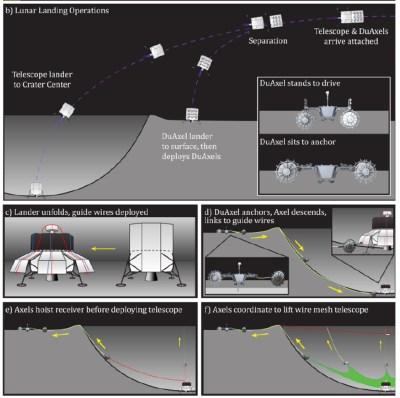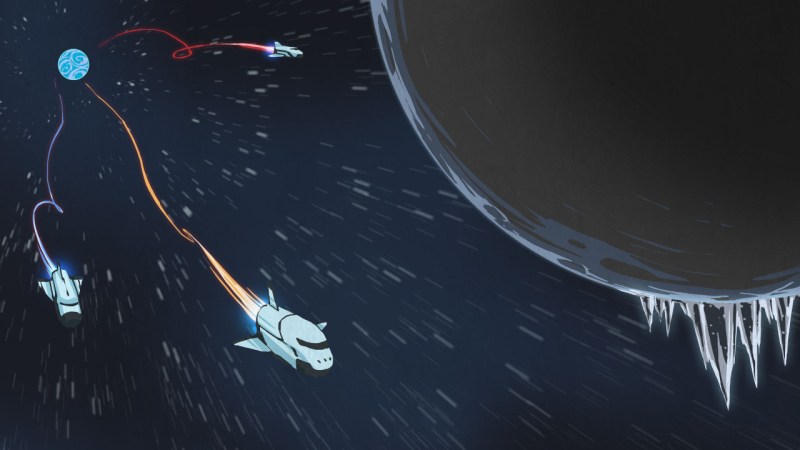The last time that a human set foot on the Moon, it was December 1972 — when the crew of the Apollo 17 mission spent a few days on the surface before returning to Earth. Since then only unmanned probes have either touched down on the lunar surface or entered orbit to take snapshots and perform measurements.
But after years of false starts, there are finally new plans on the table which would see humans return to the Moon. Not just to visit, but with the goal of establishing a permanent presence on the lunar surface. What exactly has changed that the world went from space fever in the 1960s to tepid interest in anything beyond LEO for the past fifty years, to the renewed interest today?
Part of the reason at least appears to be an increasing interest in mineable resources on the Moon, along with the potential of manufacturing in a low gravity environment, and as a jumping-off point for missions to planets beyond Earth, such as Mars and Venus. Even with 1960s technology, the Moon is after all only a few days away from launch to landing, and we know that the lunar surface is rich in silicon dioxide, aluminium oxide as well as other metals and significant amounts of helium-3, enabling in-situ resource utilization.
Current and upcoming Moon missions focus on exploring the lunar south pole in particular, with frozen water presumed to exist in deep craters at both poles. All of which raises the question of we may truly see lunar-based colonies and factories pop up on the Moon this time, or are we merely seeing a repeat of last century?
All That Never Was
Despite the often triumphant tone and chest beating around the Space Race and getting the first boots on the Moon, it’s hard to not see it as much more than a brief excursion to flex some geopolitical muscle, amidst significant tragedy. For the Soviets this tragedy struck early on, when they lost their equivalent to Werner von Braun in 1966, when Sergei Korolev died in hospital after worsening health problems. After this, many aspects of the grand Soviet space program floundered and began to disintegrate, including the ambitious Zvezda (Russian: “звезда”, meaning “star”) Moon base.

This would have been a modular base somewhat akin to the International Space Station, with nine modules that provided the 9-12 person crew with both living and working areas, with resources such as water extracted from the soil and power provided from radioisotope thermoelectric generators (RTGs) and a nuclear fission reactor. When the required superheavy N1-L3 Moon rocket failed to materialize, the Zvezda project died along with it.
After this, attempts were made to revive the Moon base idea based around new launchers, such as the Lunar Expeditionary Complex from 1974 and the Energia Lunar Expedition from 1988. Yet none of these would progress past the concept stage, as the USSR simply didn’t have the funds necessary for further lunar exploration.
On the US side of the curtain, concepts for Moon bases have been drawn up since the 1950s, with a strong interest from the military. During the 1980s and 1990s, plans were floated to have a permanent lunar colony by the 2000s, but none got the level of funding needed. Finally in 2017 NASA was able to launch the Artemis program, which will involve increasingly complex robotic and crewed missions before landing astronauts on the lunar surface in 2025.
But once again, the United States isn’t the only country in the game. The Chinese Lunar Exploration Program (CLEP) has a lunar robotic research station planned as well as a subsequent manned station. The latter manned station is called the International Lunar Research Station (ILRS), which as the name suggests, would be open to other nations.
Meanwhile India has just launched its second attempt at performing a soft landing on the Moon’s south pole with the Chandrayaan-3 mission, which is part of its larger Chandrayaan program. Much like China’s current series of Chang’e Moon missions, these are intended to explore, probe and analyze the Moon’s surface, as well as its geological and other features, although India has so far not yet managed to proceed to the stage of human spaceflight, leaving only China, the US and potentially Russia to fulfill the dream of colonizing the Moon by the 2030s, over half a century after Zvazda was planned to have been operational.
Lunar Prospects
A potentially very useful aspect of having a permanent presence on the Moon is the ability to construct and run scientific equipment like radio and optical telescopes on the far side of the Moon. Since these would face away from the Earth, they’d be shielded from most of the RF and other radiomagnetic radiation beamed out from Earth, whether from natural or human causes. One such project is the suggested NASA Lunar Crater Radio Telescope (LCRT) which would turn an entire lunar crater into a massive, 1 km diameter radio telescope.

LCRT is still being developed at JPL, with the idea being that it’d be constructed by robots, which would be delivered from Earth together with all of the materials. The tantalizing thought here is of course that if we were to have manufacturing capacity on lunar soil, much of this material for the LCRT and similar instruments could be manufactured in-situ, saving enormous costs in launching tons of materials to the Moon. When considering the Moon as a jumping off point for further space exploration, this too might be a useful feature, along with the Moon’s low gravity to make launches a snap.
After the Chinese Chang’e 5 mission returned the first lunar samples since the 1970s, analysis of the material found tiny glass beads containing significant amounts of water, presumably from asteroid impacts. This suggests that water may be more prevalent in the Moon than previously assumed, and also more widely available across the surface as well. Clearly, before we can set up manufacturing facilities on the Moon there is still a lot we have to learn, but rather than just a dusty rock in space, it would appear that it’s perhaps not as desiccated and empty as once assumed.
Much of the current and upcoming Moon missions seem to be focused on this type of exploration for probably just that reason. Which materials are available on the Moon, and in what quantities? How hard would it be to process them for ISRU, and what would be the cost-benefit between launching materials to the Moon, as well as Moon-based manufacturing and sending it to Earth? For both the Chinese (CLEP) and Russian (Luna-Glob) Moon programs, the initial focus is on setting up a robotic lunar base, which would be used for research on In-Situ Resource Utilization (ISRU) and manufacturing techniques.
Geopolitics Beyond Earth
Although the Moon is littered with Sun-faded national flags, it is hoped that no Earth nation would be able to claim something like mining rights on the Moon, let alone parts of it. This reflects the attitude towards the continent of Antarctica, which has so far been protected by the 1961 Antarctic Treaty. Yet because the very similar Outer Space Treaty (OST) is focused primarily on the use of outer space for weapons and military purposes, the 1979 Moon Treaty was created, that establishes that jurisdiction outside Earth would default to international law, with no possibility of national claims on lunar resources.
To this day, enthusiasm for the Moon Treaty has been lacking with neither the US, nor China or Russia signing it — which might signal brewing issues if a rush for lunar resources were to commence in earnest. While over the intervening half century the Moon has been left mostly alone, the Chinese program is ambitiously eyeing the end of this decade for a small robotic research base, while India and private companies are also trying their luck at lunar exploration.
Due to current geopolitical considerations, the Russian Moon program with the Luna 25 through Luna 27 landers have been postponed, and may not fly at all, depending on Roscosmos’ future. In a sense the curse on Soviet Moon exploration does seem to have remained in place.
Setting Up Camp
Even if water is more plentiful on the Moon than initially assumed, the lunar poles have a major advantage over the rest of the lunar surface in that these do not face the same brutal lunar day. One rotation of the Moon takes about a month, resulting in about two weeks of darkness and two weeks of sunlight. This means that solar power is really only a realistic option at the poles, with some areas experiencing almost continuous illumination.
For any mining and research bases elsewhere on the Moon, this would mean the use of nuclear reactors and RTGs, much as was planned for the Zvezda base. The Kilopower project, in development by NASA and the US Department of Energy (DOE), aims to produce a range of reactors which can be used on the Moon or Mars. As for why so many Moon missions target the lunar south pole rather than the north pole, this can be explained based on the suspicion of water ice in shadowed craters, of which the lunar south pole has significantly more than the north pole.
With little to differentiate both poles, and the rest of the lunar surface having been explored in more detail already by both the Apollo and various robotic missions, the south pole was an obvious exploration target, and due to the presence of more sunlight might be more suitable for a human outpost.

















What interesting features will their con-badges have?
Will the flight computer be a repurposed TRS-80?
What role will the Arduino and Raspi-Pi play in play?
What arcane coding will the residents need to know in order to troubleshoot the cranky Linux installation on their moisture vaporator?
What off-brand 3D printer nozzle will they use to print their food from the recycled nutrient amalgam paste?
Will they be able to do all of the above with a 555 timer instead?
555? La-te-dah, half a century ago they did it with transistor-resistor logic.
Transistors? Luxury! Back then we had a single 6L6 tube and we bloody LIKED it!
And it was uphill to the Moon both ways, we did it barefoot… in the snow!
I wonder if they’ll utilize the nuclear material in the hotspot for heat and electricity generation or weather they’ll just go with solar and TEGs brought from Earth.
I’m guessing it’s a lot less work to send the materials for the radio telescopes than it is to send the materials for an industrial base that can run on the Moon.
Maybe we should move the Moon into a geostationery orbit, with solar-powered ion thrusters. It would then stay in one place and cure those pesky high tides.
Think of the tides as wireless energy tranfer ….
Making it easier to write chairface onto it.
Could they write “Boaty McBoatface” in Comic Sans on one of the craters?
Not only would this never happen with current or projected future engineering talent, but the second-order effects would make climate change look like a walk in the park. Hail no, bro!
“To this day, enthusiasm for the Moon Treaty has been lacking with neither the US, nor China or Russia signing it — which might signal brewing issues if a rush for lunar resources were to commence in earnest. ”
Economics of it all holds a greater sway than words on a paper.
Are we experiencing a shortage of silicon dioxide or aluminum oxide? Going to the moon for them is idiotic, surely?
You want to build ships to travel between earth and mars? Or to mine the asteroid belt?
Building them on earth and launching them to space is VERY design constraining. Then theres launch expense, Every KG of earth minerals sent to space is thousands of dollars and soooo much pollution.
While HAD only mentions silicone dioxide and aluminum dioxide the moon in rich in titanium dioxide and iron oxide as well. Refining these into metals for use either on the moon, or after being flung into space by a rail launcher, in near lunar orbit, would spare the earth the fiscal and environmental cost of using terrestrial resources.
Do we have shortages of white pigment and rust?
No we have an excess of gravity, which makes launching rust from Earth more costly than from the moon.
How much does it cost to launch ten tons of aluminum, oxygen, water, hydrogen, or uranium into interplanetary solar orbit from Earth? How many stages of how carefully designed a rocket, and how much energy? How many failures?
Not to mention how much it costs to mine those things on Earth. It’s everywhere on the moon, and you could get it into a solar orbit with a slightly augmented golf club. That’s where the savings come in. In space, ordinary materials found OUTSIDE of large gravity wells suddenly become extraordinary.
It is only useful if you want to keep going to other planets, because the stuff on the moon doesn’t have the gravity well tax applied. You could push tons of the stuff into interplanetary Hohmann orbits for next to nothing. In fact, the dirt itself (aluminum oxide) would be an ideal propellant for getting more of it off the moon and out to Mars.
That was the 60s plan, anyway. It also involved permanent human presence and massive nuclear proliferation in space—for propulsion, power, and of course weapons. It was the cold war, after all.
Snifs sadly…Still want my own Tsar Bomba repromod (cobalt tamper)…Dreams of youth.
The Mark 17 will have to do.
If we were to mine the moon then a space elevator mounted on the moon to lift ores into space would make sense and could be constructed easier than an Earth one. On the flip side components for expanding a moon base could “ride” the elevator to the surface. However, as man mines and scours/scars for minerals on the Moons’ surface, in the far future the face of “the man in the moon” will start to show blemishes.
Oh and no storing nuclear waste on the Moon’s far side…. in a parallel reality in 1999.. it didn’t work out too well. 😁
A magnetic linear accelerator would be a better fit for launching stuff to Earth than a space elevator, but then you run into Heinlein’s “The Moon is a Harsh Mistress”
A space elevator won’t work on a tidally-locked satellite. It would simply fall. Unless you want to make it EXTREMELY long and put the other end into a Lagrange situation. Centripetal force is what would make it work on Earth, and if you want to use that force on the moon’s month-long period versus the Earth’s 24-hour one… Well, I guess it’s technically possible for those who want to write hard science fiction (and I strongly encourage that!)
Not to mention—The escape velocity on the moon is only a few hundred FPS, and the thing is literally made of the stuff the Space Shuttle’s solid fuel boosters used as propellant, so a whole space elevator would be a silly investment. You can easily launch tons and tons of raw material off the moon using the dirt around you. It would only need a manufacturing presence there. It’s so ideal! I wish we could tap it.
Postponed? I dunno about Luna 26 and 27, but 25 is on the pad and will be launched today (23:10 UTC), if everything goes as planned: https://forum.nasaspaceflight.com/index.php?topic=32948.msg2512525#msg2512525
At the time of writing this, the launch was evidently successful. Landing date is set for august 23.
If we make it to the moon again in my lifespan, I will be ecstatic. I don’t think we have what it takes anymore. Mars? Be still my heart, I won’t even try to approach that at this point.. I’m still hoping in the back of my mind that somebody will prove this cynic wrong.
Let’s hope Elon goes first!
I always wondered how the space program (and the world) would have been different if Neil Armstrong’s first words while stepping off the LEM were “I claim this Moon for the United States.”
Or if, he said “Coca-Cola!”
Gorsky wouldn’t have finally gotten his…?